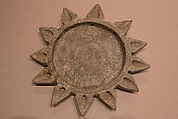Lamp
Not on view
The carving of utensils and other objects from soft stones is part of a longstanding artistic tradition in the Near East that dates back for millennia. Steatite and other related talcs (the English word is of Persian origin) are easy to carve, relatively strong and non-brittle, and are impervious to fire. Many of medieval Nishapur's stone utensils demonstrate a high degree of artistic merit, despite having been fashioned from a lowly material and serving a utilitarian function. These pieces often have powerfully sculptural forms with silhouettes that take the form of beautiful two-dimensional patterns. This lamp made of "Mashhad" stone has a circular well and twelve triangular flanges for holding wicks. The well and flanges are incised with circles with dots at their center. The rim of the well is incised with cross-hatched lines.
Due to rights restrictions, this image cannot be enlarged, viewed at full screen, or downloaded.
This artwork is meant to be viewed from right to left. Scroll left to view more.



